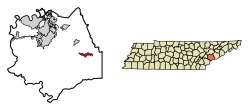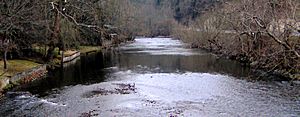Townsend, Tennessee facts for kids
Quick facts for kids
Townsend
|
||
|---|---|---|

Townsend at sunrise
|
||
|
||
| Motto(s):
Gateway to Cades Cove & Peaceful Side of the Smokies
|
||

Location of Townsend in Blount County, Tennessee.
|
||
| Country | United States | |
| State | Tennessee | |
| County | Blount | |
| Founded | 1901 | |
| Incorporated | 1921 | |
| Named for | Wilson B. Townsend | |
| Area | ||
| • Total | 1.99 sq mi (5.16 km2) | |
| • Land | 1.99 sq mi (5.16 km2) | |
| • Water | 0.00 sq mi (0.00 km2) | |
| Elevation | 1,076 ft (328 m) | |
| Population
(2020)
|
||
| • Total | 550 | |
| • Density | 275.97/sq mi (106.57/km2) | |
| Time zone | UTC-5 (Eastern (EST)) | |
| • Summer (DST) | UTC-4 (EDT) | |
| ZIP code |
37882
|
|
| Area code(s) | 865 | |
| FIPS code | 47-74860 | |
| GNIS feature ID | 2405597 | |
Townsend is a small city in Blount County, Tennessee. It became a city in 1921. People from the Little River Railroad and Lumber Company helped start it. In 2020, about 550 people lived there.
For thousands of years, different Native American groups lived in the area. Today, Townsend is one of three main entrances to the Great Smoky Mountains National Park. It has several museums and fun places to visit. These places teach about the nature and history of the Great Smokies.
Contents
History of Townsend
Native Americans were the very first people to live in Tuckaleechee Cove. This is the area where Townsend is now. The oldest things found here are from about 2000 B.C. Many pieces of pottery and old ax heads have also been found. These items are from the Woodland period, a time long ago. By 1200 A.D., Native Americans in Tuckaleechee had built a strong village. It was near the northern entrance of the cove.

The Cherokee people arrived in this area around 1600. They built many small villages along the Little River. The name "Tuckaleechee" comes from the Cherokee word Tikwalitsi. Its first meaning is not known today. An important path, the Great Indian Warpath, split here. One part went west to Cherokee towns along the Little Tennessee River. The other went south to North Carolina.
In the 18th century, a Cherokee storyteller named James Mooney shared a tale. He said the Shawnee tried to attack the Cherokee villages in Tuckaleechee. But a Cherokee leader named Deadwood Lighter had a vision. He saw where the Shawnee were hiding. The Cherokee then surprised the attackers from behind. They defeated many Shawnee and chased the rest away.
By the late 1700s, the first European-American settlers arrived. The Cherokee had already left their villages by then. They moved south and west to avoid the new settlers.
In 1843, a writer named George Washington Harris wrote about a dance. It happened in Tuckaleechee Cove on a farm. People at the dance enjoyed food like cornbread and ham. They danced to music from a fiddle and a dulcimer. To find dance partners, the men showed off their strength. The women worked on quilts.
An Irish patriot named John Mitchel lived and farmed here. He stayed with his family in the late 1850s. There is a special marker for him near US 321 and SR 73.
Logging Industry in Townsend
In the 1880s, the lumber business grew very fast. This was thanks to new tools like the bandsaw and logging railroads. Forests in other areas were used up quickly. So, logging companies looked to the mountains for wood.
In 1900, Colonel W.B. Townsend bought a huge amount of land. It was about 86,000 acres (348 km²) along the Little River. He wanted to use the untouched forests of the Smokies. The next year, Townsend started the Little River Lumber Company. The town that grew around his sawmill was named after him.
Townsend also built the Little River Railroad. This railroad carried wood products to sell. After 1909, it also brought tourists. These visitors wanted to escape the summer heat of Knoxville. They went to a resort town Townsend built called Elkmont. The railroad connected the sawmill to Walland in the west. It also followed the Little River upstream to the southeast.
Townsend quickly made money from the forests. In 1916, he said his company was still cutting a lot of wood. A single giant chestnut tree in the Smokies could make 18,000 planks of lumber. Townsend's success led to more logging all over the Smokies. By the 1930s, when the park was created, almost two-thirds of the forests had been cut down. Park managers have worked hard to bring the forests back.
The fast cutting of trees worried people who wanted to protect nature. Colonel Townsend first did not agree with them. But later, he sold 76,000 acres (308 km²) of his land in 1926. This land became part of what is now the Great Smoky Mountains National Park. Townsend lived near Elkmont in a special house. He died there in 1936.
Some people thought Townsend would struggle without the lumber business. But the new national park brought many tourists. This helped the area's economy stay strong. Even though some old resort buildings were damaged or destroyed, tourism kept the town going.
Geography of Townsend
Townsend is in the eastern part of Blount County. It sits in a place called Tuckaleechee Cove. This is one of several "limestone windows" found at the base of the Smokies. These windows form when older rocks wear away. This shows the younger rock below, which is limestone. Limestone windows are usually flatter than other mountain valleys. They often have rich, fertile soil.
Other limestone windows nearby include Cades Cove, Wear Cove, and Jones Cove. Tuckaleechee Cove is between Bates Mountain to the north and Rich Mountain to the south. About 1,500 people live in the wider cove area. The Little River starts high in the mountains. It flows from east to west through Tuckaleechee. The city of Townsend covers the eastern half of Tuckaleechee.
The city has a total area of about 5.6 square kilometers (2.2 square miles). All of this area is land. In 2004, the city grew bigger by adding more land. Townsend is part of the larger Knoxville area.
Demographics
| Historical population | |||
|---|---|---|---|
| Census | Pop. | %± | |
| 1930 | 402 | — | |
| 1940 | 378 | −6.0% | |
| 1950 | 328 | −13.2% | |
| 1960 | 283 | −13.7% | |
| 1970 | 267 | −5.7% | |
| 1980 | 351 | 31.5% | |
| 1990 | 329 | −6.3% | |
| 2000 | 244 | −25.8% | |
| 2010 | 448 | 83.6% | |
| 2020 | 550 | 22.8% | |
| Sources: | |||
2020 Census Information
| Race | Number | Percentage |
|---|---|---|
| White (non-Hispanic) | 516 | 93.82% |
| Other/Mixed | 24 | 4.36% |
| Hispanic or Latino | 10 | 1.82% |
The 2020 United States census counted 550 people living in Townsend. There were 182 households and 100 families in the city.
Transportation in Townsend
U.S. 321 is the main road in Townsend. It is also known as Lamar Alexander Parkway. This road connects Townsend to Walland and Maryville to the northwest. It also goes to Pigeon Forge to the east-northeast. In Pigeon Forge, it meets U.S. 441.
Near the eastern end of Townsend, U.S. 321 turns north and then northeast. Tennessee 73 continues straight. It then turns southeast and goes right into the national park. This road eventually meets Little River Road at a popular swimming spot called "The Y". From this spot, Cades Cove is about 7 miles (11 km) to the west. The Sugarlands and Gatlinburg are about 18 miles (29 km) to the east.
Recreation and Attractions
Townsend has many fun places to visit. It is home to the Great Smoky Mountains Heritage Center. This center protects and shares the history of the region. The Little River Railroad and Lumber Company Museum is also here. It tells the story of the area's logging past. Next to the heritage center is a new National Park Service building. It stores items from all the national parks nearby.
Tuckaleechee Caverns is also close by. This is a cave system that is about a mile long. It goes down as deep as 150 feet (46 m).
Just north and west of Townsend is the Foothills Parkway. This is a special road that goes over Chilhowee Mountain. It has many places to stop and enjoy the views from high up. You can see the Smokies to the south. You can also see the Tennessee Valley and Cumberland Plateau to the north and west. A new part of the parkway opened in late 2018. It connects Walland to Wears Valley.
Townsend also has a Kampgrounds of America (KOA) for camping.
See also
 In Spanish: Townsend (Tennessee) para niños
In Spanish: Townsend (Tennessee) para niños




